Pascale Petit's Blog
December 17, 2021
Beast of Bodmin - my commissioned poem for Cornwall AONB
When my seventh poetry collection, Mama Amazonica, won Simon Armitage's inaugural Laurel Prize, I received an extra gift – a commission to write a poem about my favourite Area of Outstanding Natural Beauty in Britain. I knew immediately I would write about Bodmin Moor – I now live in a deep valley just beneath the south-east corner of it. Every horse-lane bordered by high Cornish hedges opens to views of tors at the gate gaps. During strict lockdown I would walk the lanes and look up at always visible Sharptor and the Cheesewring. As soon as we were allowed to venture four miles by car, Brian my husband drove us to Kilmar Tor, off the bridle path that also leads to Hawkstor and Trewartha Tor. It's a steep climb to Kilmar Tor and got us fitter as it became a regular haunt. From the top, which is the third highest point in Cornwall, we can see Brown Willy, the highest tor, far across the other side of the moor, we can see Dartmoor on the horizon the other way, and the north and south coastlines. All the fauna and flora and land formations mentioned in my poem are loved discoveries. From the stonechats, skylarks, and bog asphodels, to the ponies we saw galloping across the plateau between Bearah Tor and the secret waterhole. I did what I love to do, which is to watch the pageants, while Brian took photos. I'm thrilled that Cornwall AONB have set my poem to aerial footage of the moor, grateful thanks to them, to Fin Davis for the film, and to Bodmin Way for the narration. I now have a series of moor and beast poems. Here is 'Beast of Bodmin':
Beast of Bodmin
You say I don’t exist, that the panther skull you found
in the river is fake, my alien origins
betrayed by an Indian cockroach egg-case
nestled like a ruby in my brain.
You say that walkers have heard me howl as if caught
in a trap or calling for a mate. That I escaped
from a private estate where I grew too dangerous to keep,
that I kill sheep by skinning them face-first.
That I could be pure myth – the Butterfly-Jaguar
with eyespots on my wings to frighten off humans,
that I wear a pelt of moon-moths by night.
~
Few have found my pugmarks, but they are homes to vanishing insects.
You see no gouges on the rowans,
but my claws are gorse where stonechats nest
and the spaces between my paws are tussocks
where skylarks hatch.
Each of my hairs is a recording of birdsong.
~
Sometimes you glimpse me crouched on a lightning fork,
my roar thundering downhill.
You say that my face is vast as the moorland sky,
that a raincloud parts
to give me eyes that glow in the dark.
You call me beast, but I am the hazel and oak woods
that once costumed the moor,
my veins streams that feed the valleys.
My yawn is the shaggy mists of sunrise,
my spit the lichen rags on trees.
~
I emerged from the swamp like a newly-cast mirror,
my rosettes barely visible in peat fur.
I am the curator of my own heaven
hung with paintings of starry nights
that whirl on my glossy coat.
My rosettes are not your quarries or mines
but the roses of pulsars, medals from eco-wars!
Yet all you see are rail-holes in granite sleepers of disused railways.
Extinct plants flex their colours when I run!
~
I pass through the understorey of the ghost-forest
like a photo in the developer tray, a shadow printed
with earth’s apex language.
Yet you scan snaps of me and say they’re forged.
I am the codex of unnamed species, the librarian of lost trees.
I am written in rare fonts of ambrosial inks,
in bog asphodels and heath orchids, marsh violets and sundew.
My belly is plush as sphagnum.
My ears are cists and cairns.
My breath is the wind that whips your face
and cradles the kestrel.
~
My heart is set in the slope like a reed-framed waterhole.
When the feral ponies come to bathe in me
I make them new as cave paintings that have just sprung to life.
My glance is the sheen on the stallion’s silver coat,
the spots that mark him as a leopard-horse!
His mare bursts from the surface, her eyes blazing,
her bracken coat streaked with amnion.
~
You say I don’t exist, but my bones are old as granite,
my marrow clear as the brooks that tumble
down to the valleys. My flesh is feldspar and quartz,
my tail is hoarfrost and fern flame.
~
You say I never existed, but my ancestors once roamed these heights,
their fangs became icicles dripping from cheesewrings,
their fur melted like a drift.
I could be stem cells
in the vial of a Frozen Zoo, waiting
a hundred years to awake
in my city of glass towers,
my smoking biobank.
I could be an immortal leopard
in a deep-frozen forest, surrounded by
lynx, wolf, deer – all of us dreaming
of a new Ice Age to cool the earth.
@font-face {font-family:"Cambria Math"; panose-1:2 4 5 3 5 4 6 3 2 4; mso-font-charset:0; mso-generic-font-family:roman; mso-font-pitch:variable; mso-font-signature:-536870145 1107305727 0 0 415 0;}@font-face {font-family:Calibri; panose-1:2 15 5 2 2 2 4 3 2 4; mso-font-charset:0; mso-generic-font-family:swiss; mso-font-pitch:variable; mso-font-signature:-536859905 -1073732485 9 0 511 0;}@font-face {font-family:Garamond; panose-1:2 2 4 4 3 3 1 1 8 3; mso-font-charset:0; mso-generic-font-family:roman; mso-font-pitch:variable; mso-font-signature:647 2 0 0 159 0;}p.MsoNormal, li.MsoNormal, div.MsoNormal {mso-style-unhide:no; mso-style-qformat:yes; mso-style-parent:""; margin:0cm; mso-pagination:widow-orphan; font-size:12.0pt; font-family:"Times New Roman",serif; mso-fareast-font-family:Calibri; mso-fareast-theme-font:minor-latin; mso-fareast-language:EN-US;}p.MsoHeader, li.MsoHeader, div.MsoHeader {mso-style-priority:99; mso-style-link:"Header Char"; margin:0cm; mso-pagination:widow-orphan; tab-stops:center 234.0pt right 468.0pt; font-size:12.0pt; font-family:"Times New Roman",serif; mso-fareast-font-family:Calibri; mso-fareast-theme-font:minor-latin; mso-fareast-language:EN-US;}span.HeaderChar {mso-style-name:"Header Char"; mso-style-priority:99; mso-style-unhide:no; mso-style-locked:yes; mso-style-link:Header;}.MsoChpDefault {mso-style-type:export-only; mso-default-props:yes; mso-fareast-font-family:Calibri; mso-fareast-theme-font:minor-latin; mso-fareast-language:EN-US;}div.WordSection1 {page:WordSection1;}
October 16, 2020
On Mama Amazonica winning the inaugural Laurel Prize for ecopoetry
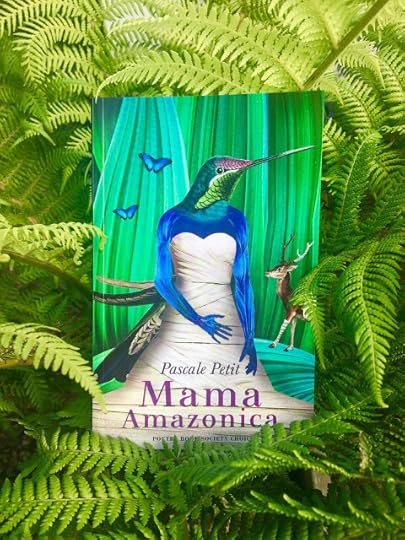
Three years after Mama Amazonica was published in 2017 by Bloodaxe, it has won the inaugural Laurel Prize. This prize was created by the Poet Laureate Simon Armitage to recognise and encourage the resurgence of environmental or nature poetry, which he felt had not quite been noticed. It is run by the Poetry School and the judges were Robert Macfarlane, Moniza Alvi, and Simon Armitage. The first prize of £5,000 is donated by Simon and is his annual laureate honorarium from the Queen. Karen McCarthy Woolf was awarded second prize for her wondrous and experimental Seasonal Disturbances, on the theme of climate change, and Colin Simms was awarded third prize for Hen Harrier, a book that focuses on one precious species. There was an extra prize for the most promising debut and this was given to Matt Howard for Gall. The inaugural prize was for the best ecopoetry collection published in the last five years, and will follow with yearly selections now.
Mama Amazonica fuses two themes: my mother's abuse by my father, and consequent mental illness, and the abused and besieged Amazon rainforest. It's a book that took me 65 years to write, and in it I managed to change my relationship with my late, estranged mother, to one of empathy and compassion, and most of all – to one of love. I did this by placing her hospital bed, not in the psychiatric ward, but inside pristine primary deep jungle, where life is at fever pitch – the psychotic human mother superimposed on Mama Amazonica, our earth mother, who is abused and exploited by humankind. I've been obsessed by the Amazon forest for 25 years, and obsessed by my mother too, so it was a fertile doubling of subjects, which grew ever deeper as I wrote them.
The book didn't get on any of the main poetry prize shortlists when it first appeared, and although I tried to ignore that, as I knew it's readers that count, but I was discouraged. So much so, that I had cast it aside as a failure, and embarked on my next collection with renewed hope. Then, miraculously, nine months after Mama Amazonica was published, it won the Royal Society of Literature's Ondaatje Prize. It was the first time a poetry collection had won, and only the second time one had been shortlisted. Now that Mama Amazonica has also won the Laurel Prize, a poetry prize, I have to believe that what I set out to do with it worked for quite a few judges. But I also want to offer hope to other poets whose collections might be overlooked. It is so important to keep believing in your work – if you feel in your heart that it's achieved something valuable, keep faith, and you never know what might happen later. I also want to thank Simon Armitage for founding this visionary prize, at a time when the health of our planet is about to be damaged beyond repair unless we act. Even writing helps!
Here are some photos from my trips to the Peruvian Amazon where I researched for the poems.

view of the Madre de Dios and Tambopata rivers from small plane to Tambopata from Puerto Maldonado (photo credit Pascale Petit)

On an oxbow lake off the Tambopata River (photo by Brian Fraser)

Giant river otter aka river wolf in oxbow lake near Tambopata Research Center (photo credit Paul F. Condori, our guide aka Jungle Paul)
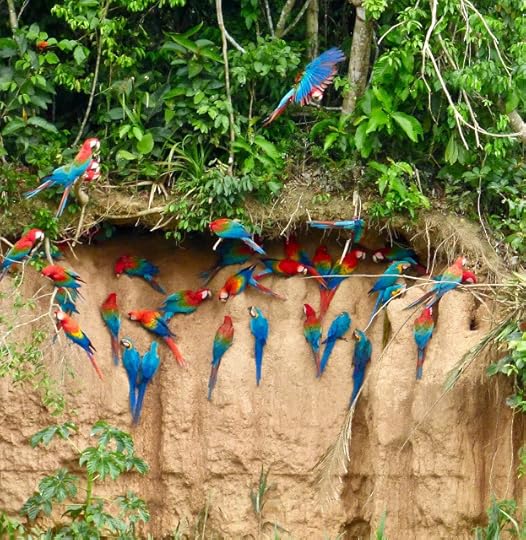
Macaws at the clay lick near Tambopata Research Center (photo credit Brian Fraser)

The author under an ironwood (photo by Brian Fraser)

Monkey frog on night jungle trek (photo by Brian Fraser)
July 19, 2020
The Anthropocene ��� how I wrote a poem from Tiger Girl
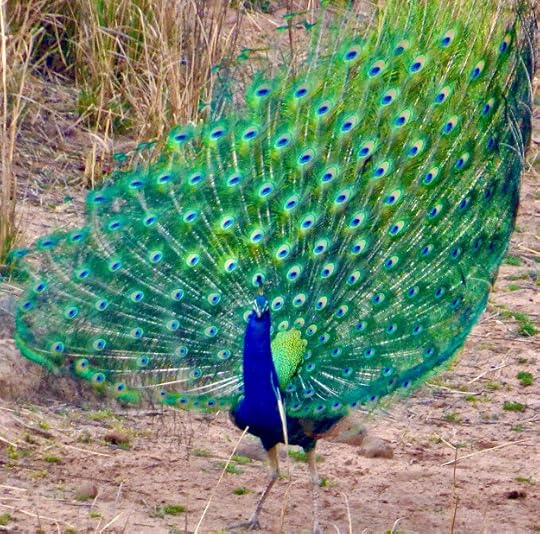
A Gond myth tells how, "When the peacock dances in the forest, everything watches, and the trees change their form to turn into flaming feathers".
If there is a single sound that evokes the tiger forests of India it is the call of peacocks. When I hear that call I can see the trees watching as the male dances, his fanned tail shivering with an infrasonic hum, while a tiger prowls in the grass nearby, waiting to pounce. According to the Gond tribe, who once lived in these forests, the peacock's dance can turn the trees' branches into plumes, each evergreen sal leaf an eye.
I came across pictures online of a Chinese bride wearing a dress and train made from three thousand peacock plumes, and this, together with the Gond myth of the trees transforming into peacocks, and the series of storms and hurricanes circling the Atlantic at the time, sparked my poem 'The Anthropocene', which was recently featured in New Statesman, and will appear in my eighth collection, Tiger Girl , published by Bloodaxe this September.
The Anthropocene
A bride wears a train
of three thousand
peacock plumes
She walks down the aisle
like a planet
trailing her seas
every wave an eye
shivering with the memory
of the display
how the trees turned
to watch as the bird
raised the fan of his tail ���
emerald forests
bronze atolls
lapis islands
every eye
a storm
held in abeyance
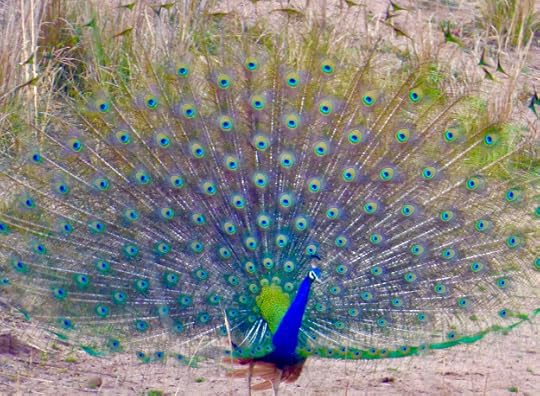 Photo credits of peacocks in Bandhavgarh National Park �� Brian Fraser
Photo credits of peacocks in Bandhavgarh National Park �� Brian Fraser <font size="5"><span style="font-family: times;"><!-- /* Font Definitions */ @font-face {font-family:"MS Mincho"; panose-1:2 2 6 9 4 2 5 8 3 4; mso-font-alt:"������ ������"; mso-font-charset:128; mso-generic-font-family:modern; mso-font-pitch:fixed; mso-font-signature:-536870145 1791491579 134217746 0 131231 0;} @font-face {font-family:"Cambria Math"; panose-1:2 4 5 3 5 4 6 3 2 4; mso-font-charset:0; mso-generic-font-family:roman; mso-font-pitch:variable; mso-font-signature:-536870145 1107305727 0 0 415 0;} @font-face {font-family:"\@MS Mincho"; panose-1:2 2 6 9 4 2 5 8 3 4; mso-font-charset:128; mso-generic-font-family:modern; mso-font-pitch:fixed; mso-font-signature:-536870145 1791491579 134217746 0 131231 0;} /* Style Definitions */ p.MsoNormal, li.MsoNormal, div.MsoNormal {mso-style-unhide:no; mso-style-qformat:yes; mso-style-parent:""; margin:0cm; margin-bottom:.0001pt; mso-pagination:widow-orphan; font-size:12.0pt; mso-bidi-font-size:10.0pt; font-family:"Times New Roman",serif; mso-fareast-font-family:"MS Mincho"; mso-fareast-theme-font:minor-fareast; mso-fareast-language:EN-US;} .MsoChpDefault {mso-style-type:export-only; mso-default-props:yes; font-size:10.0pt; mso-ansi-font-size:10.0pt; mso-bidi-font-size:10.0pt; mso-fareast-font-family:"MS Mincho"; mso-fareast-theme-font:minor-fareast; mso-ansi-language:EN-US; mso-fareast-language:JA;}size:595.2pt 841.8pt; margin:72.0pt 89.85pt 72.0pt 4.0cm; mso-header-margin:35.45pt; mso-footer-margin:35.45pt; mso-paper-source:0;} div.WordSection1 {page:WordSection1;}</span></font>
The Anthropocene – how I wrote a poem from Tiger Girl

A Gond myth tells how, "When the peacock dances in the forest, everything watches, and the trees change their form to turn into flaming feathers".
If there is a single sound that evokes the tiger forests of India it is the call of peacocks. When I hear that call I can see the trees watching as the male dances, his fanned tail shivering with an infrasonic hum, while a tiger prowls in the grass nearby, waiting to pounce. According to the Gond tribe, who once lived in these forests, the peacock's dance can turn the trees' branches into plumes, each evergreen sal leaf an eye.
I came across pictures online of a Chinese bride wearing a dress and train made from three thousand peacock plumes, and this, together with the Gond myth of the trees transforming into peacocks, and the series of storms and hurricanes circling the Atlantic at the time, sparked my poem 'The Anthropocene', which was recently featured in New Statesman, and will appear in my eighth collection, Tiger Girl , published by Bloodaxe this September.
The Anthropocene
A bride wears a train
of three thousand
peacock plumes
She walks down the aisle
like a planet
trailing her seas
every wave an eye
shivering with the memory
of the display
how the trees turned
to watch as the bird
raised the fan of his tail –
emerald forests
bronze atolls
lapis islands
every eye
a storm
held in abeyance
 Photo credits of peacocks in Bandhavgarh National Park © Brian Fraser
Photo credits of peacocks in Bandhavgarh National Park © Brian Fraser <!-- /* Font Definitions */ @font-face {font-family:"MS Mincho"; panose-1:2 2 6 9 4 2 5 8 3 4; mso-font-alt:"MS 明朝"; mso-font-charset:128; mso-generic-font-family:modern; mso-font-pitch:fixed; mso-font-signature:-536870145 1791491579 134217746 0 131231 0;} @font-face {font-family:"Cambria Math"; panose-1:2 4 5 3 5 4 6 3 2 4; mso-font-charset:0; mso-generic-font-family:roman; mso-font-pitch:variable; mso-font-signature:-536870145 1107305727 0 0 415 0;} @font-face {font-family:"\@MS Mincho"; panose-1:2 2 6 9 4 2 5 8 3 4; mso-font-charset:128; mso-generic-font-family:modern; mso-font-pitch:fixed; mso-font-signature:-536870145 1791491579 134217746 0 131231 0;} /* Style Definitions */ p.MsoNormal, li.MsoNormal, div.MsoNormal {mso-style-unhide:no; mso-style-qformat:yes; mso-style-parent:""; margin:0cm; margin-bottom:.0001pt; mso-pagination:widow-orphan; font-size:12.0pt; mso-bidi-font-size:10.0pt; font-family:"Times New Roman",serif; mso-fareast-font-family:"MS Mincho"; mso-fareast-theme-font:minor-fareast; mso-fareast-language:EN-US;} .MsoChpDefault {mso-style-type:export-only; mso-default-props:yes; font-size:10.0pt; mso-ansi-font-size:10.0pt; mso-bidi-font-size:10.0pt; mso-fareast-font-family:"MS Mincho"; mso-fareast-theme-font:minor-fareast; mso-ansi-language:EN-US; mso-fareast-language:JA;}size:595.2pt 841.8pt; margin:72.0pt 89.85pt 72.0pt 4.0cm; mso-header-margin:35.45pt; mso-footer-margin:35.45pt; mso-paper-source:0;} div.WordSection1 {page:WordSection1;}
June 27, 2020
Prize Photograph, a new poem from Tiger Girl
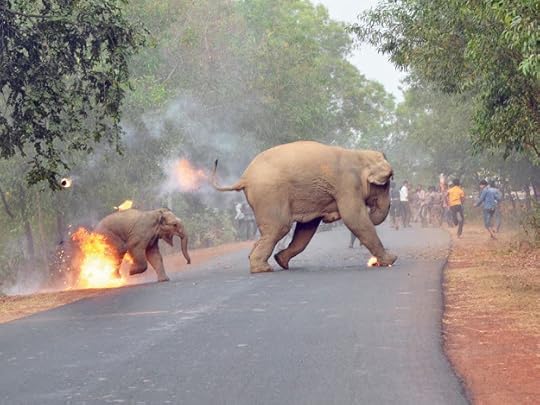
Photograph with permission of the photographer Biplap Hazra
Biplap Hazra, who took this prizewinning shot, has kindly given me permission to post his image here and on this week's edition of One Hand Clapping magazine. This terrifying photo provoked my poem 'Prize Photograph', which is featured in One Hand Clapping, and will appear in Tiger Girl , my eighth collection, to be published by Bloodaxe on 3rd September. Biplap later said that the calf survived the attack.
I saw wild elephants in Bandhavgarh National Park in Madhya Pradesh, though the ones I saw were ones that had just been captured by the park elephant handlers, to tame for tiger patrols, as poaching is such a threat to the tigers. Every morning the mahouts ride their elephants to scout for the cats and check their safety – one bull came up to our gypsy jeep and demanded the banana he'd scented in my bag – I had no choice but to offer my breakfast. Being up close to those brandy topaz eyes – the Gypsy is open and I was on the top seat – is unforgettable, as is being felt by the soft but persistent trunk. Wild elephants don't usually include Bandhavgarh in their migration corridors, but they entered with newborns, so the zones they lingered in had to be closed to tourists. That they wander from their usual routes is worrying, as it can mean their migration forests are closed to them, or felled. In this photo, they are under siege from farmers, who are trying to protect their homes and crops.
Prize Photograph
And this wild elephant, crossing State Highway 9 –
his footprints lakes for dragonflies and bees –
does not yet know the chaff of a howdah,
ankle chains, or the sting of the bull hook.
His mother is ahead, her ears flapping
for his rumbles that she also feels through her feet.
Only now her feet are burning, and she’s
closed her ears to the firecrackers, the jeers
of the mob protecting their fields. Already
one farmer has hung himself when his crop
and home were trampled – how could he feed his family?
And one woman has been crushed to death.
The men lob tar firebombs at the invaders –
go back jungli haathi! they shout, banging
on tin drums. The matriarch runs from the noise,
doesn’t hear her calf scream, his back legs alight.
Hell is now and here the caption will say
as Biplap Hazra clicks the shot of his life.
<!-- /* Font Definitions */ @font-face {font-family:"Cambria Math"; panose-1:2 4 5 3 5 4 6 3 2 4; mso-font-charset:0; mso-generic-font-family:roman; mso-font-pitch:variable; mso-font-signature:-536870145 1107305727 0 0 415 0;} @font-face {font-family:Calibri; panose-1:2 15 5 2 2 2 4 3 2 4; mso-font-charset:0; mso-generic-font-family:swiss; mso-font-pitch:variable; mso-font-signature:-536859905 -1073732485 9 0 511 0;} /* Style Definitions */ p.MsoNormal, li.MsoNormal, div.MsoNormal {mso-style-unhide:no; mso-style-qformat:yes; mso-style-parent:""; margin:0cm; margin-bottom:.0001pt; mso-pagination:widow-orphan; font-size:12.0pt; font-family:"Times New Roman",serif; mso-fareast-font-family:Calibri; mso-fareast-theme-font:minor-latin; mso-fareast-language:EN-US;} .MsoChpDefault {mso-style-type:export-only; mso-default-props:yes; mso-fareast-font-family:Calibri; mso-fareast-theme-font:minor-latin; mso-fareast-language:EN-US;}size:612.0pt 792.0pt; margin:72.0pt 72.0pt 72.0pt 72.0pt; mso-header-margin:36.0pt; mso-footer-margin:36.0pt; mso-paper-source:0;} div.WordSection1 {page:WordSection1;}May 21, 2020
Green Bee-eater ��� a poem from Tiger Girl

Tiger Girl will now be published by Bloodaxe on 3rd September 2020, postponed from June because of Covid-19, and in the lead-up I will post occasional poems from the book, together with photos of the Indian wildlife they celebrate. This is the green bee-eater, elusive to the lens, but captured here by my beloved (even his tongue!) when we were in Bandhavgarh National Park in Madhya Pradesh, this time last year ��� what a contrast to this year! But the birdlife there is matched by the wonders that visit our garden in Cornwall this May, every day bullfinches, goldfinches, greater spotted woodpeckers, dunnocks, nuthatches, collared doves, blackbirds, and many many more, come to feed here. It is a rainforest lush with ferns and nettles and wildflowers. It has been a memorable lockdown, and continues to be.
I wrote 'Green Bee-eater', out of fascination for this masked forest in miniature, and prompted by coming across his song being described as a "tree-tree-tree". I was so happy that Poetry magazine published it in the April 2020 issue, along with 'Swamp Deer', thank you editors. There are a number of short bird and deer poems threaded through Tiger Girl, and I hope this one offers us some hope.
Green Bee-eater
More precious than all
the gems of Jaipur ���
the green bee-eater.
If you see one singing
tree-tree-tree
with his space-black bill
and rufous cap,
his robes
all shades of emerald
like treetops glimpsed
from a plane,
his blue cheeks,
black eye-mask
and the delicate tail streamer
like a plume of smoke ���
you might dream
of the forests
that once clothed
our flying planet.
And perhaps his singing
is a spell
to call our forests back ���
tree
by tree
by tree.
Green Bee-eater – a poem from Tiger Girl

Tiger Girl will now be published by Bloodaxe on 3rd September 2020, postponed from June because of Covid-19, and in the lead-up I will post occasional poems from the book, together with photos of the Indian wildlife they celebrate. This is the green bee-eater, elusive to the lens, but captured here by my beloved (even his tongue!) when we were in Bandhavgarh National Park in Madhya Pradesh, this time last year – what a contrast to this year! But the birdlife there is matched by the wonders that visit our garden in Cornwall this May, every day bullfinches, goldfinches, greater spotted woodpeckers, dunnocks, nuthatches, collared doves, blackbirds, and many many more, come to feed here. It is a rainforest lush with ferns and nettles and wildflowers. It has been a memorable lockdown, and continues to be.
I wrote 'Green Bee-eater', out of fascination for this masked forest in miniature, and prompted by coming across his song being described as a "tree-tree-tree". I was so happy that Poetry magazine published it in the April 2020 issue, along with 'Swamp Deer', thank you editors. There are a number of short bird and deer poems threaded through Tiger Girl, and I hope this one offers us some hope.
Green Bee-eater
More precious than all
the gems of Jaipur –
the green bee-eater.
If you see one singing
tree-tree-tree
with his space-black bill
and rufous cap,
his robes
all shades of emerald
like treetops glimpsed
from a plane,
his blue cheeks,
black eye-mask
and the delicate tail streamer
like a plume of smoke –
you might dream
of the forests
that once clothed
our flying planet.
And perhaps his singing
is a spell
to call our forests back –
tree
by tree
by tree.
November 11, 2019
Tiger Girl has a cover!
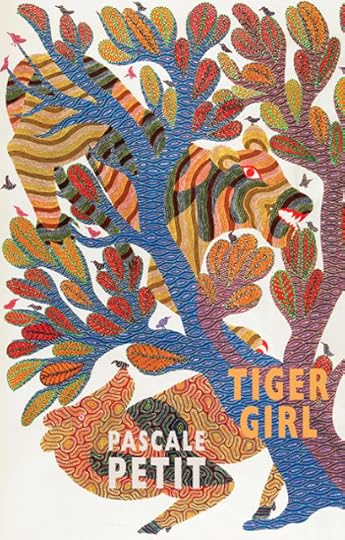 My eighth collection, Tiger Girl, has a cover! It will be published by Bloodaxe in June 2020. I've almost finished writing the poems, editing and sequencing them, at that stage of taking a few more out, inserting a few new ones that have arrived by surprise. You can pre-order the book from Amazon now, here is the link to more information on my Bloodaxe page.
My eighth collection, Tiger Girl, has a cover! It will be published by Bloodaxe in June 2020. I've almost finished writing the poems, editing and sequencing them, at that stage of taking a few more out, inserting a few new ones that have arrived by surprise. You can pre-order the book from Amazon now, here is the link to more information on my Bloodaxe page. The painting on the cover is by the Pardhan Gond tribal artist Jangarh Singh Shyam ‘The story of the tiger and the boar’. Shyam was the first of these artists to become internationally known.
The painting is wrapped around the outer edge of the back cover, I love what Neil Astley and Pamela Robertson-Pearce, from Bloodaxe, have done with the design.

Pascale Petit’s Tiger Girl marks a shift from the Amazonian rainforests of her previous work to explore her grandmother’s Indian heritage and the fauna and flora of subcontinental jungles. Tiger girl is the grandmother, with her tales of wild tigers, but she’s also the endangered predators Petit encountered in Central India. In exuberant and tender ecopoems, the saving grace of love in an otherwise bleak childhood is celebrated through spellbinding visions of nature, alongside haunting images of poaching and species extinction.
Tiger Girl is Pascale Petit’s eighth collection, and her second from Bloodaxe, following Mama Amazonica, winner of the Royal Society of Literature’s Ondaatje Prize 2018 – the first time a poetry book won this prize for a work of fiction, non-fiction or poetry best evoking the spirit of a place. Four of her earlier collections were shortlisted for the T.S. Eliot Prize.
‘No one writing in English today comes anywhere near the exuberance of Pascale Petit. Rarely has the personal and environmental lament found such imaginative fusion, such outlandish and shocking expression that is at once spectacularly vigorous, intimate and heartbroken.’ – Daljit Nagra (judge for the RSL Ondaatje Prize 2018)
‘Beautifully sad, the imagery inexhaustible, the sorrow and torment both tempered and sharpened by the relish for language and the ingenuity of the imagination.’ – Simon Armitage on Mama Amazonica
October 19, 2018
Mama Amazonica goes Into the Forest for BBC Radio 3's The Verb

To research for Mama Amazonica (Bloodaxe Books, 2017) I went to the Peruvian Amazon twice, once in the wet season and once in the dry. Tonight, I talk about my book on Radio 3's The Verb, with a gang of forest-lovers – the poet Claire Trévien, Kate Arnold on her dulcimer – lead of the group 'Fear of the Forest', Terry Deary, Jack Bernhardt, and our host Ian McMillan. It was a bit nerve-wrecking but Ian kept us amused and we had fun. I must admit I was thrilled to be chatting about one of my very favourite things – forests! The Amazon rainforest in my case, that very endangered, abused, dangerous, but wondrous place. Mama Amazonica is immersed in it, but is also my mentally ill mother, a double exposure where love floresces. It's just over a year since the book came out and I've been extremely lucky that in May it won the RSL Ondaatje Prize 2018 – an award given for a book evoking the spirit of place. Here are just a few pics I took in Tambopata National Reserve, though the birds – jacamar, king vultures and blue-and-gold macaws, are taken by my husband Brian.







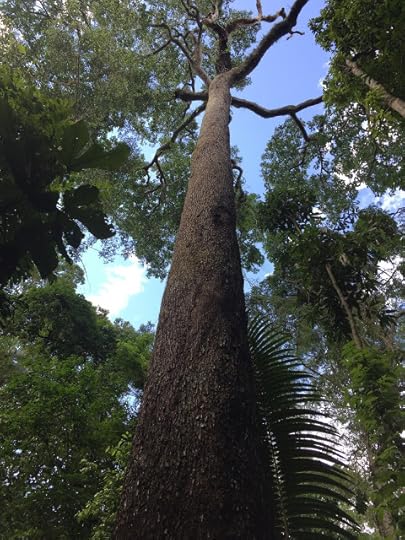

November 11, 2017
Butterflies and moths of the Peruvian Amazon: writing Mama Amazonica

I've been meaning to collect all my photos of butterflies, moths and caterpillars taken in Tambopata National Reserve last year, so here they are, some taken by me with my iPhone and some by Brian with his camera. Of course these are only the ones we managed to capture, and don't include the zipping morphos like a blue lightning flash, or the clearwings transparent as glass, or the moths that sometimes bumped into our flashlights on nightwalks, the leaf butterflies that resemble dead crumpled leaves. But I've looked up their names and labelled them as well as I could. Some were big as my hand.
The clouding ones, that gather on the clay riverbanks to suck minerals, greeted us almost every time we walked the narrow plank off the boat and climbed the slippery mud steps then endless steep and rickety wooden steps up the sheer bank. What a contrast they made, with the dirt of the mud and leaf litter and their silky luminous colours. In my poem 'Black Caiman with Butterflies' in Mama Amazonica, butterflies are "the beauty of the world", but it's a beauty that needs to drink mud and caiman and turtle eyes, that, like the metallic morphos, must feed on rotting fruit.
There were times too when our guides, Berli Carpio on our first trip and Jungle Paul on our second, did not know the names of the butterflies, and there might well have been ones we saw that have no names, that have never been seen before. In our lodge at Tambopata Research Center entomologists are cataloguing new species every month.
 Phoebis philea and Anteos menippe butterflies feeding on minerals in mud
Phoebis philea and Anteos menippe butterflies feeding on minerals in mud 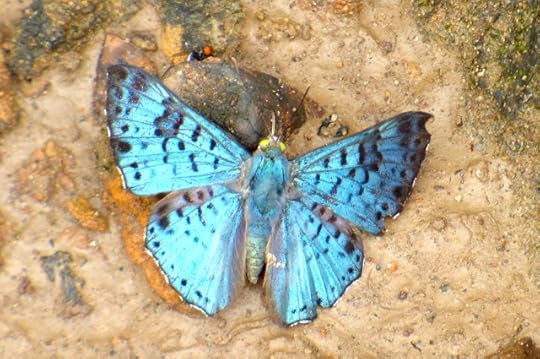 Lasaia agesilas butterfly on the riverbank
Lasaia agesilas butterfly on the riverbank Heliconia
Heliconia Caterpillar seen on nightwalk in forest trail
Caterpillar seen on nightwalk in forest trail Uranius dayflying moths on riverbank
Uranius dayflying moths on riverbank Lasala agesilas with 88 butterfly and horsefly on riverbank
Lasala agesilas with 88 butterfly and horsefly on riverbank Hummingbird hawkmoth
Hummingbird hawkmoth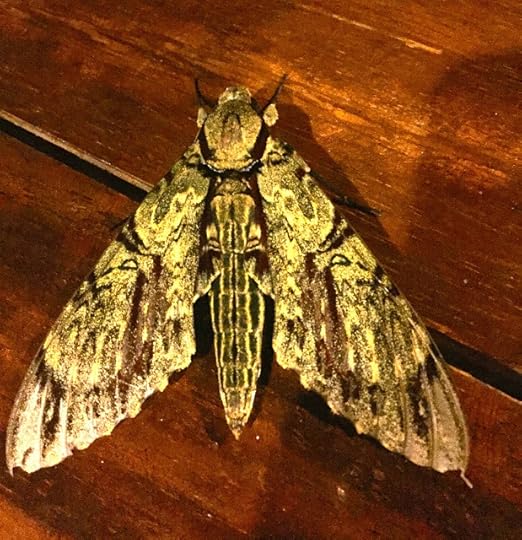 Sphinx moth I saw on the dinner table, large as my hand
Sphinx moth I saw on the dinner table, large as my hand Dyson's blue doctor with 88 butterfly (see also first pic of Blue doctor)
Dyson's blue doctor with 88 butterfly (see also first pic of Blue doctor) small morpho?
small morpho? Owl butterfly seen near the pond in the island
Owl butterfly seen near the pond in the island  Red-barred Amarynthis
Red-barred Amarynthis  Mystery caterpillar on nightwalk in forest
Mystery caterpillar on nightwalk in forest More Uranius moths (and why not?)
More Uranius moths (and why not?) Julia butterflies or flambeaux on an oar in oxbow lake
Julia butterflies or flambeaux on an oar in oxbow lake Flambeaux and snowy-whites drinking caiman tears
Flambeaux and snowy-whites drinking caiman tears Heliconid
Heliconid



